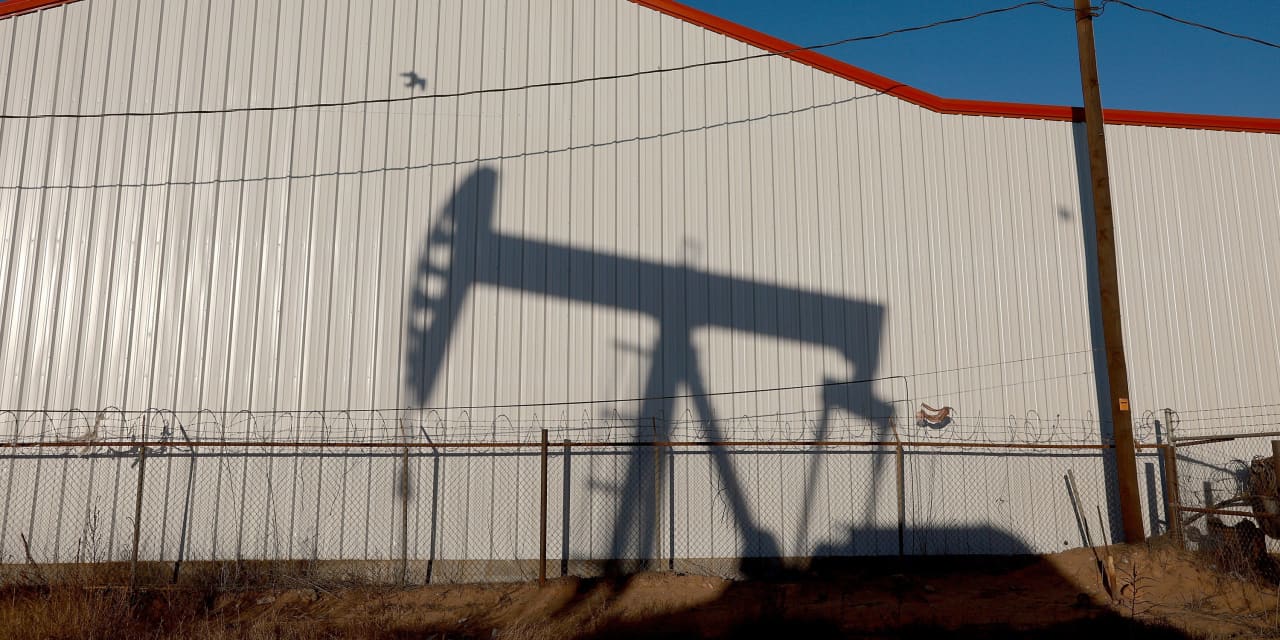Oil futures settled higher Tuesday, with U.S. benchmark prices marking a seventh straight session gain, as traders continued to weigh risks to crude supplies tied to Middle East tensions and energy-demand prospects.
Natural-gas futures, meanwhile, moved lower for a sixth consecutive session, settling at their lowest level since July 2020 on expectations for weaker U.S. demand and excess supplies.
Price moves
-
West Texas Intermediate crude
CL00,
+1.09%
for March delivery
CL.1,
+1.09% CLH24
rose 95 cents, or 1.2%, to settle at $77.87 a barrel on the New York Mercantile Exchange. -
April Brent crude
BRN00,
-0.31% BRNJ24,
+0.89% ,
the global benchmark, added 77 cents, or 0.9%, at $82.77 a barrel on ICE Futures Europe. -
March gasoline
RBH24,
+0.98%
climbed nearly 1.2% to $2.39 a gallon, while March heating oil
HOH24,
+1.15%
edged down by 0.8% to $2.90 a gallon. -
Natural gas for March delivery
NGH24,
-5.08%
settled at $1.69 per million British thermal units, down 4.5%.
Oil’s market drivers
Crude oil held up well Tuesday “in the face of headwinds from a rising U.S. dollar and an OPEC report that suggested some, but not complete progress toward implementing production cuts,” said Colin Cieszynski, portfolio manager and chief market strategist at SIA Wealth Management.
In a monthly report Tuesday, the Organization of the Petroleum Exporting Countries left its forecast for growth in oil demand this year unchanged from its January outlook at 2.2 million barrels a day, or mbd, bringing total demand to 104.4 mbd.
One bright spot was that markets in Japan and South Korea rallied overnight, Cieszynski told MarketWatch. Since concerns about the impact of struggling Asia-Pacific economies on energy demand have been weighing on crude lately, “it appears some of that pressure may have lifted for the moment.”
WTI, the U.S. benchmark, logged a sixth straight gain Monday, while Brent edged lower. Both grades had rallied more than 6% last week as jitters over the potential for conflict in the Middle East to threaten crude supply were once again on the rise.
Given the lack of a clear direction in Middle East tensions, the oil market is “operating like a yo-yo, bouncing around up and down, but not really going anywhere,” said Manish Raj, managing director at Velandera Energy Partners. “Unfortunately in the Middle East, all developments are more of the same — bombings, followed by ceasefire talks, then followed by more bombings.”
“The oil market is ‘operating like a yo-yo, bouncing around up and down, but not really going anywhere.’”
Still, traders are betting that the risk is “all to the upside, since spare capacity is only in the hands of the guys who have vowed to not overproduce: OPEC,” said Raj.
Meanwhile, interest-rate expectations have been “pared back more recently but traders remain upbeat on the economic outlook,” Craig Erlam, senior market analyst at Oanda, said in a note. Of course, “the further back the first rate cuts are pushed, the less confident people will be, which could weigh on oil prices,” he said.
Data released Tuesday showed that U.S. consumer prices rose by a sharper-than-expected 0.3% in January while the rate of inflation remained stuck above 3%, raising the potential that the Federal Reserve will change its interest-rate plans.
Also see: Gold futures fall toward ‘critical support point’ of $2,000 an ounce after inflation report
Natural gas
On Nymex, natural-gas prices extended their plunge to a sixth session in a row, their longest daily losing streak since the eight-session drop ended Oct. 20, 2023, according to Dow Jones Market Data.
Read: Natural-gas prices at lowest since 2020 on mild weather, ample supply ‘double whammy’
Traders may have already written off this winter’s natural-gas heating demand and are looking ahead to “shoulder season,” said Cieszynski. The shoulder months are the months between the winter’s heating season and the summer’s cooling season.
U.S. natural-gas stocks in storage continue to stand well above the five-year average, according to the Energy Information Administration, which will issue its weekly update on domestic supplies Thursday.
Still, a “late-winter storm, should one materialize, could shift sentiment rapidly,” said Cieszynski.
Read the full article here


